
Many of my friends are members of the “sandwich generation”–caring both for children and for their own parents. That’s difficult enough right now, and as a new report from the Institute for the Future (IFTF) points out, caring for our aging population is only going to get more challenging. Right now we have 7 potential caregivers for everyone needing care in the US–by 2030 that number will drop to 4.  Traditionally, the responsibility for elder care has fallen to family members, but IFTF reminds us that a number of factors, including declining marriage and birth rates, an increase in the number of women in the workplace, a rising number of people with disabilities and fewer facilities caring for the aging, will impel us to build new support systems.
Traditionally, the responsibility for elder care has fallen to family members, but IFTF reminds us that a number of factors, including declining marriage and birth rates, an increase in the number of women in the workplace, a rising number of people with disabilities and fewer facilities caring for the aging, will impel us to build new support systems.
To help us imagine these new systems, IFTF has released Caregiving 2031, three video scenarios that explore how we can avoid a crisis in eldercare. Their hope is that some of the strategies suggested by these scenarios may inspire real-world solutions.
Your Futurist Friday assignment: watch IFTF’s Neighbors Care video [3 minutes], which explores a future in which we redefine what “family” means like.
Think about what this means for your own life. Who do you expect to take care of you as you age? What systems in your community would make it easier to create the future you want for yourself and your family? And what roles do or could museums play in this network of care?
You can find all three video scenarios, along with a toolkit for exploring the future of caregiving, at IFTF Caregiving 2031.









Comments